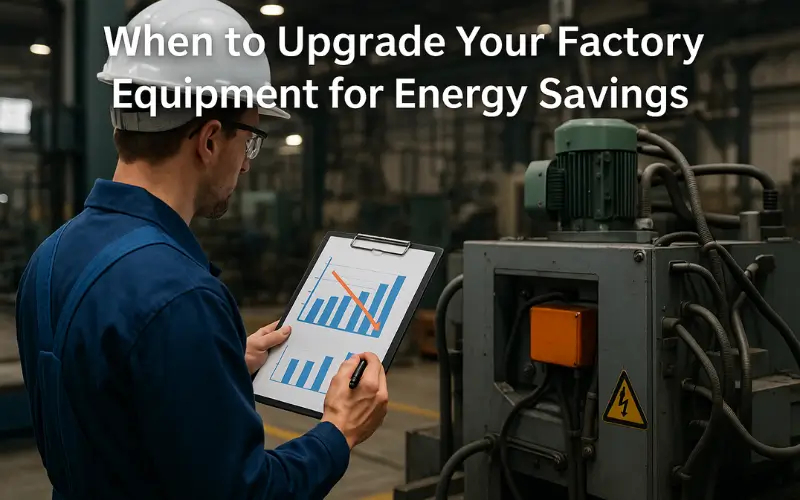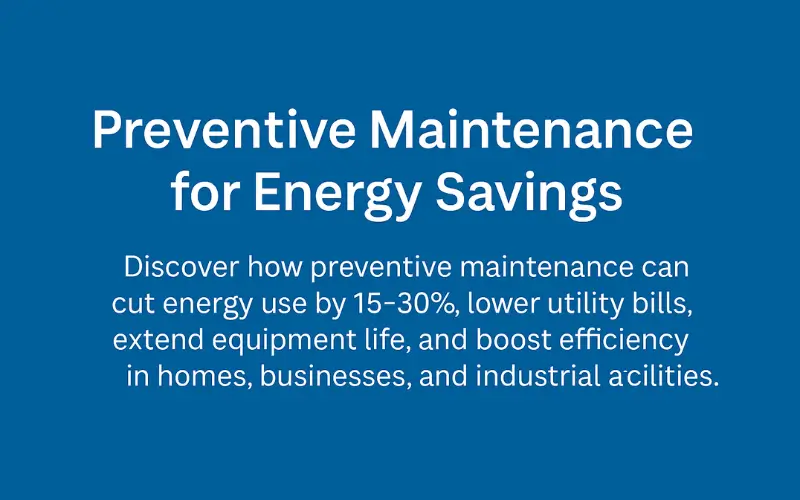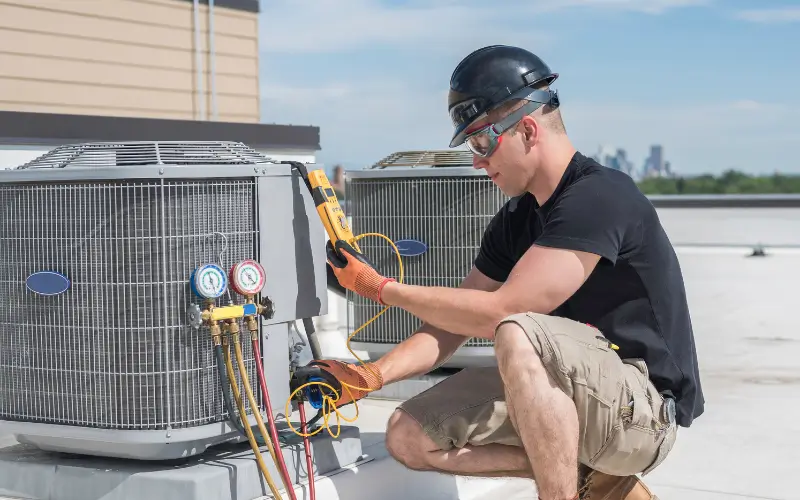In today’s competitive manufacturing landscape, every kilowatt counts. Energy isn’t just another utility bill — it’s a strategic cost driver that directly impacts your bottom line, environmental footprint, and ability to stay competitive. For many factories, the hidden culprit behind rising energy bills is aging, inefficient equipment quietly draining resources every hour it runs.
Upgrading equipment for energy savings isn’t simply about buying something new; it’s about knowing when an upgrade makes financial and operational sense. Replace too early, and you may waste capital that could be better invested elsewhere. Wait too long, and you’ll pay the price in higher energy bills, mounting maintenance costs, unplanned downtime, and even missed compliance requirements.
This guide will walk you through:
- How to identify the right time to upgrade based on energy audits, performance data, and lifecycle costs.
- Which upgrades yield the biggest energy savings in factory environments.
- Financial tools and incentives that can make upgrades cost-effective — or even cash-flow positive from day one.
- Implementation strategies to roll out upgrades without disrupting production.
When an Upgrade is Usually the Right Choice
Before diving into detailed analysis and calculations, it helps to know the most common red flags that signal it’s time to replace or retrofit factory equipment. If you’re nodding “yes” to several of these, an upgrade should be on your immediate radar.
1. The equipment is well past its expected service life
Every machine type has a general “economic life” — for example:
- Motors: 10–15 years
- Air compressors: 10–12 years
- Boilers: 20–25 years
- HVAC units: 15–20 years
Once equipment exceeds these benchmarks, efficiency drops and operating costs climb, even with regular maintenance.
2. Frequent breakdowns and rising maintenance costs
If maintenance logs show that repair costs are rising year over year — especially for the same issues — you’re probably spending more than the cost of financing a newer, more efficient model.
3. Energy bills trending upward without production increases
When energy consumption rises but output stays flat, it’s a clear indicator of declining efficiency. This “energy drift” often comes from worn components, poor controls, and obsolete technology.
4. Spare parts are hard to find or discontinued
Delays in getting parts increase downtime risk. In some cases, suppliers may charge a premium for obsolete parts, further tipping the balance toward replacement.
5. The equipment fails to meet current safety or environmental standards
Stricter energy-efficiency and emissions regulations mean older machines may put your plant at legal or reputational risk.
6. Payback for an upgrade is shorter than continued operation
If lifecycle cost analysis shows that the savings from an upgrade will cover the purchase in three to five years (or less), it’s generally wise to proceed.
7. You need capacity or capability improvements
Upgrades aren’t just about energy. Newer equipment can also boost production speed, improve quality, and integrate with digital monitoring systems — giving you both efficiency and performance gains.
Perform an Energy Audit and Baseline Assessment
Upgrading factory equipment without first knowing exactly where and how you’re losing energy is like replacing a car engine without opening the hood. The first step in any well-justified upgrade plan is to run a structured energy audit and establish a clear baseline.
Why Start with an Audit?
An energy audit:
- Identifies the biggest energy users (“energy hogs”) in your plant.
- Quantifies potential savings from different upgrade options.
- Helps prioritize projects with the fastest return.
- Creates a defensible case for management or investor approval.
Types of Energy Audits
1. Walk-Through Audit (Preliminary)
- Quick, low-cost scan to spot obvious inefficiencies.
- Useful for finding “low-hanging fruit” like leaks, idle machines left running, and outdated lighting.
2. Detailed (General) Audit
- Involves submetering, load measurements, and detailed cost-benefit calculations.
- Typically spans several days to weeks.
- Generates a prioritized list of energy-saving measures, including equipment upgrades.
3. Investment-Grade Audit (IGA)
- Comprehensive engineering and financial analysis.
- Used for large capital projects or performance contracts.
- Often includes vendor proposals, lifecycle cost models, and guaranteed savings projections.
What Data to Collect
During the audit, gather:
- Energy bills (electricity, gas, steam, compressed air) for the past 12–24 months.
- Submeter readings for specific machines or lines.
- Operating hours and load profiles for major equipment.
- Maintenance logs to identify chronic failures or inefficiencies.
- Production output data to normalize energy usage (e.g., kWh per unit produced).
Tools & Standards to Use
- DOE/EERE “Best Practices” guides for industrial systems.
- EPA ENERGY STAR® Portfolio Manager for benchmarking.
- ISO 50002 for standardized energy auditing processes.
- Data loggers and portable analyzers to track consumption patterns.
Output: The Baseline
From the audit, establish:
- Current energy use per machine/system.
- Cost per unit of production (e.g., $/ton, $/piece).
- Performance benchmarks against industry standards.
- Prioritized list of potential upgrade targets with estimated kWh/fuel savings.
A good baseline not only tells you where you are today, but also lets you verify later whether the upgrade achieved its promised savings.
Decision Criteria – How to Decide Between Repair, Retrofit, or Replace
Once you’ve completed your energy audit and have a clear baseline, the next step is choosing the smartest course of action for each piece of equipment. The decision often boils down to three options: keep repairing, retrofit with efficiency upgrades, or replace entirely.
The right choice depends on a combination of technical, financial, and strategic factors.
1. Age & Remaining Useful Life (RUL)
Rule of thumb: If equipment has less than 25–30% of its expected service life left, a replacement should be seriously considered.
Examples:
- A 14-year-old motor (typical life: 15 years) is a high upgrade candidate.
- A 7-year-old compressor (typical life: 12 years) might still justify a retrofit instead.
2. Energy Performance Gap
- Compare actual performance to new, high-efficiency models.
- Example: A standard 100 HP motor operating at 91% efficiency replaced with a premium-efficiency motor at 96% can save ~4–5% in electricity costs annually.
- Factor in load profile — lightly loaded machines may benefit more from controls (VFDs) than full replacement.
3. Maintenance & Downtime Costs
- Track annual repair spend and unplanned downtime hours.
- Tip: If yearly maintenance costs exceed 5–10% of the equipment’s replacement value, it’s often better to replace.
4. Parts Availability & Compliance Risks
- Obsolete or discontinued components increase both downtime and repair cost.
- Older machines may also fail to meet updated safety, environmental, or energy regulations — adding compliance risk.
5. Lifecycle Cost Analysis (LCCA)
Rather than looking only at purchase price, calculate total cost over the equipment’s remaining life.
Include:
- Purchase/retrofit cost
- Energy cost
- Maintenance cost
- Downtime cost
- Resale/salvage value
Simple Payback Formula:
Payback (years) = Upgrade Cost ÷ Annual Savings
Net Present Value (NPV) and Internal Rate of Return (IRR) can add more precision.
6. Strategic Fit
- Will the upgrade help meet upcoming production capacity needs?
- Does it integrate with Industry 4.0 / smart factory plans?
- Can it improve product quality or flexibility alongside energy savings?
Decision Matrix Example
| Factor | Weight | Repair | Retrofit | Replace |
| Energy savings potential | 25% | Low | Medium | High |
| Maintenance cost trend | 20% | High | Medium | Low |
| Compliance readiness | 15% | Low | Medium | High |
| Remaining useful life | 20% | Low | Medium | High |
| Strategic alignment | 20% | Low | Medium | High |
Scoring this way helps bring objectivity to the decision.
Which Equipment Upgrades Give the Biggest Energy Wins
Not all equipment upgrades deliver the same bang for your buck. While every factory has its unique processes and priorities, some upgrades consistently produce high returns in both energy savings and operational performance across industries.
1. Electric Motors & Motor-Driven Systems
- Why they matter: Motors account for 60–70% of industrial electricity use.
Upgrade options:
- Replace standard motors with premium-efficiency motors.
- Add Variable Frequency Drives (VFDs) to match motor speed with load demand.
- Ensure motors are correctly sized to avoid inefficiency at partial loads.
Typical savings: 3–10% from motor replacement; 20–50% with VFDs on variable-load applications.
2. Compressed Air Systems
Why they matter: Inefficient systems waste up to 30% of compressed air energy.
Upgrade options:
- Right-size compressors to actual demand.
- Install sequencers and better controls.
- Repair leaks and maintain optimal pressure levels.
Typical savings: 20–30% through optimization and new equipment.
3. Boilers, Steam Systems & Heat Recovery
Why they matter: Steam generation is a major fuel consumer.
Upgrade options:
- Replace old boilers with high-efficiency or condensing models.
- Add economizers to recover heat from flue gases.
- Improve insulation and condensate recovery.
Typical savings: 10–20% fuel reduction.
4. HVAC & Ventilation Systems
Why they matter: Heating, cooling, and ventilation can be significant non-process energy loads.
Upgrade options:
- High-efficiency chillers and heat pumps.
- Demand-controlled ventilation.
- Energy recovery ventilators (ERVs) for heat exchange.
Typical savings: 15–30% depending on climate and system design.
5. Industrial Refrigeration & Process Cooling
Upgrade options:
- Replace outdated compressors with efficient screw or scroll types.
- Install floating head pressure controls.
- Use VFDs on fans and pumps.
Typical savings: 15–25%.
6. Lighting Systems
Upgrade options:
- Switch to LED fixtures with smart controls (motion sensors, daylight harvesting).
Typical savings: 50–70% compared to older fluorescent or HID lighting.
7. Process-Specific Machines
Examples: presses, ovens, conveyors, CNCs, washers, dryers.
Upgrade paths:
- Switch to servo-driven systems.
- Replace resistive heating with infrared or induction.
- Integrate energy-efficient drives and automation.
8. Controls, Sensors & Automation
Why they matter: Even efficient machines waste energy if poorly controlled.
Upgrade options:
- Install programmable logic controllers (PLCs) with energy management modules.
- Add IoT sensors for real-time monitoring and predictive maintenance.
Typical savings: 5–15% just from improved control.
Retrofit vs. Replace vs. Refurbish
Once you’ve identified a candidate for improvement, the next question is how to upgrade. In most cases, you’ll be choosing between retrofitting, full replacement, or refurbishing. Each approach comes with its own cost profile, downtime implications, and long-term benefits.
1. Retrofit – Modernizing Existing Equipment
Definition: Adding new components or technologies to existing machines to improve efficiency, functionality, or compliance.
Typical examples:
- Adding VFDs to motors.
- Upgrading burners in boilers.
- Installing advanced controls and automation.
- Improving insulation or seals.
Pros:
- Lower upfront cost than full replacement.
- Less downtime than total replacement.
- Can capture significant energy savings quickly.
Cons:
- Limited by the condition and design of the existing equipment.
- May not deliver the same performance as brand-new systems.
- Shorter remaining life expectancy compared to replacement.
When to choose:
- Equipment is relatively young, structurally sound, and the retrofit addresses the main inefficiency.
2. Replace – Full Equipment Swap
Definition: Removing the old unit and installing a new, high-efficiency model.
Pros:
- Highest possible efficiency gains.
- Eliminates hidden reliability issues.
- New warranty and full lifecycle ahead.
- Often qualifies for maximum rebates/incentives.
Cons:
- Highest upfront capital cost.
- Longer downtime for installation and commissioning.
- Requires full procurement process and possible retraining.
When to choose:
Equipment is old, inefficient, unreliable, or non-compliant with current standards — and replacement offers a strong ROI within 3–5 years.
3. Refurbish – Restoring Equipment to Like-New Condition
Definition: Disassembling, repairing, and replacing worn parts to restore original performance.
Pros:
- Lower cost than replacement.
- Extends life by several years.
- Useful for specialty or custom-built machines.
Cons:
- Efficiency gains are modest compared to modern equipment.
- Risk of repeat issues if design is outdated.
- May not meet new efficiency regulations.
When to choose:
The machine’s base design is sound, replacement is cost-prohibitive, and energy savings are not the primary driver.
Quick Decision Guide
| Situation | Best Option |
| Equipment <10 years old, inefficiency from controls/components | Retrofit |
| Equipment >15 years old, frequent failures, poor efficiency | Replace |
| Equipment custom-built, structurally solid, moderate efficiency issues | Refurbish |
Measurement & Verificat ion (M&V) – Ensure Projected Savings Become Real Savings
Many energy upgrade projects look great on paper but fail to deliver the promised savings once installed. The only way to be sure your investment is paying off is to implement a Measurement & Verification (M&V) plan.
Why M&V Matters
- Confirms whether projected savings are actually achieved.
- Helps identify performance issues early.
- Builds credibility for future upgrade projects.
- Required for many incentives, rebates, and financing programs.
1. Choose an M&V Approach
The International Performance Measurement and Verification Protocol (IPMVP) outlines four main options:
| IPMVP Option | Description | Best For |
| A – Retrofit Isolation (Key Parameter Measurement) | Measures key performance parameters only; others estimated. | Simple retrofits where savings are easy to quantify (e.g., VFD install). |
| B – Retrofit Isolation (All Parameter Measurement) | Measures all relevant parameters directly. | Complex single-system upgrades. |
| C – Whole Facility | Uses utility meters to measure total facility savings. | Multiple measures at once or plant-wide programs. |
| D – Calibrated Simulation | Computer modeling calibrated to measured data. | New construction or major plant redesign. |
2. Establish a Baseline
- Use pre-upgrade data from your audit: kWh, fuel usage, production output, operating hours.
- Normalize for external factors like weather, production volume, and operating shifts.
3. Collect Post-Upgrade Data
- Use submeters, data loggers, and control system reports.
- Monitor for at least one full operating cycle (monthly or seasonal).
4. Analyze & Report
- Compare actual post-upgrade consumption to the adjusted baseline.
- Calculate savings in both energy units (kWh, m³, liters) and monetary terms.
- Track additional benefits like reduced downtime or improved product quality.
5. Maintain Continuous Improvement
- Keep sensors and monitoring in place where possible.
- Use data to inform preventive maintenance and further efficiency opportunities.
Financials – Costing, Incentives & Funding Options
Investing in energy-saving equipment upgrades requires careful financial planning to ensure your project delivers attractive returns and aligns with budget constraints. Understanding costs, available incentives, and financing options can make the difference between a stalled proposal and a greenlit project.
1. Estimating Costs and Savings
Capital Expenditure (CAPEX):
- Includes purchase price, installation, commissioning, and training.
Operating Expenses (OPEX):
- Energy costs, maintenance, and spare parts over the equipment life.
Savings:
- Primarily energy cost reductions, but also lower maintenance and downtime costs.
2. Incentive Programs
- Utility Rebates: Many utilities offer rebates for high-efficiency equipment or audits.
- Government Grants and Tax Credits: Look for local and national programs targeting industrial energy efficiency.
- On-Bill Financing: Some utilities allow you to finance upgrades with repayments on your energy bill.
- Energy Service Companies (ESCOs): Partner with ESCOs that guarantee savings and provide financing.
3. Financing Structures
- Leasing: Reduces upfront capital needs, spreads payments over time.
- Performance Contracting: Pay for upgrades through guaranteed energy savings.
- Green Loans: Low-interest loans focused on sustainable projects.
- Internal Capital Budgeting: Use company funds with a clear ROI and payback plan.
4. Sample Payback Scenarios
| Upgrade Type | CAPEX ($) | Annual Savings ($) | Payback (years) |
| Motor Replacement | 20,000 | 5,000 | 4 |
| VFD Installation | 10,000 | 3,000 | 3.3 |
| Boiler Retrofit | 50,000 | 15,000 | 3.3 |
Consider sensitivity analyses around energy prices and production levels to stress-test your business case.
5. Tips for Budget Approval
- Bundle multiple small projects for bigger impact.
- Highlight co-benefits like improved production or reduced emissions.
- Prepare clear documentation and pilot results.
- Engage finance early to align on risk and return expectations.
Implementation Plan – From Pilot to Plantwide Rollout
A structured, phased approach maximizes success and minimizes disruption when upgrading factory equipment. Starting small and scaling thoughtfully helps prove value and build organizational buy-in.
1. Stakeholder Alignment
- Engage operations, maintenance, finance, and procurement teams early.
- Clarify goals, timelines, roles, and responsibilities.
- Address concerns around downtime, costs, and training.
2. Pilot Design
- Select a manageable area or equipment with clear baseline data.
- Define measurable objectives (energy savings, reliability).
- Develop a risk mitigation plan for downtime or unexpected issues.
3. Procurement Best Practices
- Write detailed specifications emphasizing energy efficiency and lifecycle cost.
- Consider bundled service contracts for installation, commissioning, and maintenance.
- Evaluate multiple vendors and check references for reliability and support.
4. Installation & Commissioning
- Schedule work during planned downtime windows.
- Use qualified technicians and follow OEM guidelines.
- Verify proper setup and test all controls and sensors.
5. Operator Training
- Train staff on new system operation and energy-saving practices.
- Provide easy-to-use manuals and quick reference guides.
6. Post-Installation M&V and Continuous Improvement
- Collect data according to the M&V plan.
- Analyze results and share with stakeholders.
- Identify lessons learned and opportunities for further upgrades.
Risk Management & Operational Considerations
Upgrading factory equipment to save energy can bring big benefits but also carries operational risks. Managing these proactively ensures a smooth transition without hurting productivity or safety.
1. Minimizing Production Disruption
- Plan installations during scheduled maintenance or low-production periods.
- Use phased rollouts to avoid shutting down entire lines.
- Keep spare parts and backup equipment on hand to reduce downtime risk.
2. Warranty, Spare Parts & Aftermarket Support
- Verify warranty coverage for new or retrofitted equipment.
- Ensure availability of spare parts for the foreseeable future.
- Select vendors with strong local support and service networks.
3. Cybersecurity and Data Integration
- For upgrades involving smart controls and IoT, implement cybersecurity best practices.
- Protect control systems from unauthorized access.
- Plan for data integration into existing plant management software.
4. Regulatory Compliance & Safety
- Confirm new equipment meets all relevant safety and environmental regulations.
- Train operators on updated safety procedures related to new technology.
- Managing these factors well will reduce risks and maximize the long-term success of your energy-saving upgrades.
Case Studies & Real-World Examples
Seeing real projects in action helps translate theory into practical insights. Here are a few concise examples of energy-saving equipment upgrades in factories.
Case Study 1: Motor Replacement in a Textile Factory
Situation: A 15-year-old 75 HP motor running continuously at 85% efficiency.
Action: Replaced with a premium-efficiency motor rated at 95%.
Results:
- Energy savings of ~5,000 kWh/year.
- Payback period: 3.5 years based on energy cost savings alone.
- Reduced maintenance costs and unplanned downtime.
Case Study 2: Compressed Air System Optimization in a Food Processing Plant
Situation: Leaks and oversized compressors leading to wasted energy.
Action: Leak repairs, installed sequencers and VFDs, downsized compressors.
Results:
- 25% reduction in compressed air energy use.
- Annual savings of $18,000.
- Improved system reliability.
Case Study 3: Industry 4.0 Retrofit at an Automotive Parts Manufacturer
Situation: Older presses and conveyors with no real-time energy monitoring.
Action: Installed IoT sensors, energy analytics dashboard, and automated controls.
Results:
- 12% reduction in overall energy use within six months.
- Early fault detection reduced downtime by 20%.
- Data-driven decisions enabled further targeted upgrades.
Practical Checklist – 10 Questions to Answer Before You Upgrade
Before committing to an equipment upgrade for energy savings, make sure you’ve thoroughly evaluated these key points:
How old is the equipment, and what is its typical service life?
Is it near or beyond the end of its economic life?
Have you performed a comprehensive energy audit and established a baseline?
Do you understand current energy use and inefficiencies clearly?
What is the total lifecycle cost of repair, retrofit, or replacement?
Have you included energy, maintenance, and downtime costs?
Are spare parts readily available, and what are the risks of downtime?
Does the equipment meet current safety, environmental, and regulatory standards?
What are the estimated energy savings from different upgrade options?
Have you quantified the expected reduction in energy use and costs?
Are there financial incentives or rebates available to offset costs?
What is the payback period, and is it acceptable for your organization?
How will the upgrade integrate with existing systems and future plans?
Will it support digital controls, automation, or capacity expansion?
Is there a plan for measurement, verification, and continuous improvement?
How will you ensure savings are realized and sustained?
Typical Timelines & Phased Rollout Sample Calendar
Upgrading factory equipment for energy savings is a complex project that benefits from careful scheduling and phased implementation. Below is a typical timeline to guide your planning:
| Phase | Duration | Key Activities |
| Energy Audit | 2–6 weeks | Data collection, site visits, baseline setup |
| Decision Making | 1–2 weeks | Analysis, financial modeling, approvals |
| Pilot Project | 1–3 months | Select pilot equipment, procurement, installation, M&V |
| Evaluation | 1 month | Data analysis, report, lessons learned |
| Plantwide Rollout | 3–12 months | Phased equipment upgrades, ongoing M&V, training |
Sample Gantt Chart Overview
- Months 1–2: Complete audit and baseline report.
- Month 3: Make upgrade decisions and get budget approval.
- Months 4–6: Conduct pilot installation and start M&V.
- Month 7: Evaluate pilot results and adjust rollout plan.
- Months 8–18: Gradually roll out upgrades plantwide in manageable phases.
Tips for Smooth Scheduling
- Coordinate with production schedules to minimize downtime.
- Communicate timelines and expectations clearly with all stakeholders.
- Use pilot results to refine cost and savings estimates for the full rollout.
Frequently Asked Questions (FAQs)
1. When is the best time to replace a factory machine for energy reasons?
Typically, when the equipment is near the end of its expected service life, shows rising energy consumption without production gains, or requires frequent costly repairs.
2. How do I calculate payback for an equipment upgrade?
Divide the total upgrade cost by the annual energy and maintenance savings to get the payback period in years.
3. Should we repair, refurbish, or replace old equipment?
It depends on age, efficiency, maintenance costs, and strategic needs. Repair if equipment is relatively new; refurbish if structurally sound but outdated; replace if very old or inefficient.
4. What equipment upgrades deliver the fastest energy savings?
Motor replacements with premium-efficiency models, VFD installations, compressed air leak repairs, and lighting retrofits typically yield quick wins.
5. How accurate are vendor savings claims?
Vendor claims can be optimistic. Always verify with independent audits, pilot projects, and Measurement & Verification (M&V) plans.
6. What incentives or rebates are available for industrial energy upgrades?
Many utilities and governments offer rebates, grants, tax credits, and financing programs—check local resources and utility websites.
7. How do I run a low-risk pilot for an energy-efficiency upgrade?
Start with a small scope, clear metrics, stakeholder buy-in, and a solid rollback plan in case issues arise.
8. What is the role of controls and IoT in reducing energy consumption?
Smart controls and IoT enable real-time monitoring, predictive maintenance, and demand-based operation, improving efficiency and uptime.
9. How do I measure energy savings after an upgrade?
Implement a Measurement & Verification (M&V) plan based on IPMVP protocols, comparing baseline and post-upgrade consumption normalized for production and weather.
10. Can energy-efficiency upgrades improve production as well as save energy?
Yes, many upgrades reduce downtime, improve process control, and increase capacity or product quality.




